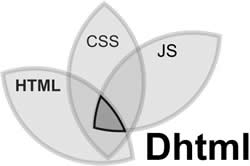Difference Between DHTML and XML
Key difference: DHTML is essentially Dynamic HTML. It is a new way of looking at and controlling the standard HTML codes and commands. DHTML is a collection of technologies that are used to create interactive and animated web sites. XML stands for Extensible Markup Language. It is a specification developed by the W3C. It is a markup language designed especially for Web documents. It defines a set of rules for encoding documents in a format that is both human-readable and machine-readable.
 DHTML is essentially Dynamic HTML. It is a new way of looking at and controlling the standard HTML codes and commands. DHTML is a collection of technologies that are used to create interactive and animated web sites. DHTML gives more control over the HTML elements. It allows one to incorporate a client-side scripting language, such as JavaScript, a presentation definition language, such as CSS, and the Document Object Model in HTML web pages.
DHTML is essentially Dynamic HTML. It is a new way of looking at and controlling the standard HTML codes and commands. DHTML is a collection of technologies that are used to create interactive and animated web sites. DHTML gives more control over the HTML elements. It allows one to incorporate a client-side scripting language, such as JavaScript, a presentation definition language, such as CSS, and the Document Object Model in HTML web pages.
DHTML also allows the pages to change at any time, without returning to the Web server first. It allows scripting languages to change a web page's look and function after the page has been fully loaded and during the viewing process. It also allows the user to add effects to their pages that are otherwise difficult to achieve.
Wikipedia list additional DHTML features, such as DHTML allows the developers to:
- Animate text and images in their document, independently moving each element from any starting point to any ending point, following a predetermined path or one chosen by the user.
- Embed a ticker that automatically refreshes its content with the latest news, stock quotes, or other data.
- Use a form to capture user input, and then process, verify and respond to that data without having to send data back to the server.
- Include rollover buttons or drop-down menus.
 XML stands for Extensible Markup Language. It is a specification developed by the W3C. It is a markup language designed especially for Web documents. It defines a set of rules for encoding documents in a format that is both human-readable and machine-readable. It allows designers to create their own customized tags. It also enables the definition, transmission, validation, and interpretation of data between applications and organizations.
XML stands for Extensible Markup Language. It is a specification developed by the W3C. It is a markup language designed especially for Web documents. It defines a set of rules for encoding documents in a format that is both human-readable and machine-readable. It allows designers to create their own customized tags. It also enables the definition, transmission, validation, and interpretation of data between applications and organizations.
XML is a text-based data format with strong support via Unicode for languages. It emphasizes simplicity, generality, and usability over the Internet. It is also widely used for the representation of arbitrary data structures, especially in web services. Programmers often use APIs while processing XML data and schema systems to aid in the definition of XML-based languages.
The XML syntax has formed the basis for many document formats, such as RSS, Atom, SOAP, and XHTML. In fact, XML-based formats have become the default for many office-productivity tools, including Microsoft Office, OpenOffice.org and LibreOffice, and Apple's iWork.
Some differences between DHTML and XML:
- DHTML is used to position information in a web page, and XML is used to describe that information.
- DHTML is HTML with JavaScript actions, whereas XML is more of universal way to transport info than a markup language.
- DHTML is used to display the dynamic web site pages, whereas XML is a markup language designed especially for Web documents.
- XML is an extensible markup language that was developed to retain the flexibility and power of HTML while reducing most of the complexity.
Image Courtesy: mediaspins.com, e-xmlmedia.com









Add new comment